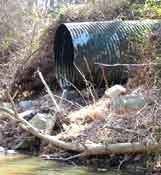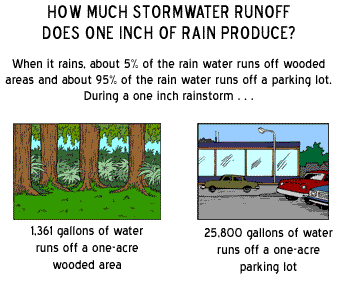 Stormwater and Streams Stormwater and Streams
When rain, snow or sleet fall to the ground, some of the water soaks into the ground and some runs off across the land surface. Always on the move, water flows downhill over and through the land to the nearest waterway. From there, the water moves through Prince Williams network of over 1,000 miles of creeks and rivers, which all eventually flow into the Potomac River and then to the Chesapeake Bay.
Water, the universal solvent, picks up pollutants as it moves across the land's surface, including fertilizers, pesticides, automobile emissions and other human byproducts. Soil particles, dislodged by the impact from raindrops hitting the ground and from sites cleared of vegetation, are carried to waterways with the moving stormwater. This increases the transfer of pollutants to waterways because many pollutants attach to soil particles. It also moves fertile soils from the land to creeks, rivers and bays.

When the sediments enter the waterway, they have a dramatic impact on the aquatic ecosystem. Sediments also remain suspended in the water column and clear waters become murky. When the sediments are pulled downward by gravity, they fill in the spaces on the rocky bottoms of streams, eliminating the habitat for the aquatic creatures (food for fish, birds and others) that live under and around these rocks.
Prince William is a rapidly suburbanizing area with significant amounts of impervious surfaces (roads, roofs, sidewalks, etc.). Impervious surfaces do not allow water to soak into the ground. The effect of these impervious surfaces is a significant increase in amounts of stormwater runoff.
While this increase in runoff proportionally increases the amounts of sediments and pollutants moving from the land to waterways, the sheer volume of water entering creeks and rivers also has serious repercussions. The force generated by these large volumes of water tears vegetation from creek banks, scours creek bottoms and overwhelms the natural boundaries of the waterway. Additionally, stormwater moving across impervious surfaces picks up the heat stored in these surfaces. When this water enters the waterway and begins to flow downstream, the effects from the heat have a cumulative impact.
 Imagine you are an aquatic creature living in a Prince William creek. During every average rainstorm your habitat is deluged with large volumes of hot, polluted water and becomes a place where your survival is endangered. And after the rain, you must contend with the pollutants and suspended sediments that remain. Over time your habitat becomes smaller, as the suspended sediments fall to the bottom and cover the nooks and crannies where you hunted for food and hid from predators. Imagine you are an aquatic creature living in a Prince William creek. During every average rainstorm your habitat is deluged with large volumes of hot, polluted water and becomes a place where your survival is endangered. And after the rain, you must contend with the pollutants and suspended sediments that remain. Over time your habitat becomes smaller, as the suspended sediments fall to the bottom and cover the nooks and crannies where you hunted for food and hid from predators.
Over time, high quality waterways cannot withstand this onslaught of stormwater. Habitat conditions in these waterways will eventually approximate those found in drainage ditches. Creeks and rivers will become merely extensions of constructed stormwater systems. Does this matter? What part does clean water play in your day to day life? These are questions every citizen must consider. Once the damage is done the costs to restore waterways to the winnable, drinkable and fishable conditions required by the Clean Water Act are significant.
The investment needed to begin restoring water quality throughout Virginia and fulfill commitments to begin preventative measures is significant. Currently the estimated costs to clean up Virginia's most critical waterways overwhelm the available funds. Success will require participation, of both dollars and time, from all stakeholders: government, businesses and citizens. As members of a community and stewards of our environment, we will be required to pay one way or the other . . . either through decreased quality of life or by making an investment in our future. The choice is there for each one of us to make. Which price are we willing to pay? |